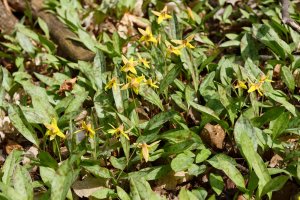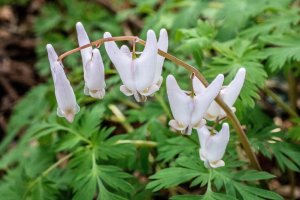Signs of the Season: Spring Ephemerals
April 5, 2023
By Erin Parker, Interpretive Services Supervisor
Ah, spring in Michigan! Today might be sunny and 60 degrees and tomorrow’s forecast might include snow. While the fluctuating weather may frustrate humans and throw a wrench into our plans, there are many organisms that take advantage of the unique environment of early spring.
Imagine walking through the woods in early April and consider what you might find. Tree branches are still leafless, allowing stronger spring sunlight to penetrate to the forest floor. Woodland soils, covered in last autumn’s leaves, may still be insulated and pockets of snow or ice might be found in shady corners. The forest floor is likely wet with a combination of spring rain and melting winter snow. These are the ideal conditions for a group of flowering plants that we call spring ephemerals.
Spring ephemerals provide the first colors of the spring, by bursting into bloom before they are shaded out by the leafy tree canopy of summer. These flowers include plants like bloodroot, bluebells, trout lilies, spring beauty, trilliums, Dutchmen’s breeches, and hepatica. Most of these plants are small, and they depend on both the rich, wet soils of woodlands and the sun that only reaches them during these few early weeks of spring. After blooming, the foliage and flowers die back and won’t be found again til the next spring. They’ll continue growing underground, storing up their energy for their next burst of energetic aboveground growth.

Tricks and Treats
These early blooming flowers are important in our woodland ecosystems as they provide nectar and food to emerging insects such as bumblebees, ants, and a variety of bees, wasps, and flies. Many spring ephemerals take advantage of hungry insects with special structures called eliaosomes that are full of proteins and fats. Ants are attracted to the eliaosomes and carry them back to their colonies. The ants consume the edible structure and discard the seed hidden inside, thereby dispersing and planting new plants.
Other flowers, such as Dutchmen’s breeches, which look like big puffy pants hanging on a closeline, are pollinated by bumblebees. Queen bumblebees are the only members of their colonies to survive the winter, waiting out the cold underground. When they emerge in the spring, they’re looking for food and a new place to start their new colony. Bumblebees are strong enough to push their way into the tubes of Dutchmen’s breeches where they collect nectar to eat and the plant coats them with pollen.

As the bumblebees move from plant to plant, the pollen on their fuzzy bodies is left behind, pollinating the flowers while the bees get their nectar snacks. The timing of natural events such as the emergence of bumble bee queens and the blooming of Dutchmen’s breeches and related plants like Squirrel Corn is called phenology.
A changing forest
The conditions that support a diverse spring bloom are becoming harder to find in southeast Michigan. These plants require undisturbed forest soils rich in organic matter such as decaying leaves. While we may not notice soils most of the time, they are teaming with life and changes to the soil can be catastrophic. Earth worms are an example of a threat to our indigenous woodland flora. Earthworms, all introduced to the Great Lakes since the last glacial period, are excellent decomposers of the same organic matter that spring ephemerals require and change the structure, moisture, and organic matter content of forest soils.
Another threat to spring blooms is the white-tailed deer population through Michigan. These herbivores aren’t just consuming your backyard hostas and tulips, they also preferentially graze on many of the spring ephemerals, including trilliums. Deer populations can decimate an understory of their favorite flowers. Throughout the Metroparks, deer ‘exclosures’ are set up where staff can annually compare the plants in areas where deer freely graze and where they are prevented from reaching their favorite foods. The diversity of wildflowers within the deer exclosures is impressive, especially compared to the diversity outside the fenced areas.
Deer also may contribute to the problem of non-indigenous plants spreading through our forests and fields. Plants that were introduced to North America from Europe, Asia, and other continents are not preferred by our herbivores and can often spread unchecked. This lack of consumption of these plants by deer, rabbits, insects, and others, paired with heavy grazing of indigenous wildflowers and other understory plants, may give aggressive plants an additional boost.
Take action, enjoy the spring
One of the most important things we can all do for spring ephemerals is get out every April and May and enjoy this short season. Noting where these plants are and when they bloom each year can be helpful in marking changes in our local parks and backyards, especially if you document them with community science tools such as iNaturalist, a free app that uses your phone’s camera to identify organisms.
As gardeners and homeowners, we can reduce non-indigenous plants and make sure we manage those that are prone to escaping into the woods. We can plant native plants wherever possible.
And finally, volunteer with a local organization (including your Metroparks!) to participate in opportunities to reduce non-indigenous plants in our forests. Reducing the spread of these non-native plants can open up the conditions for our indigenous flowers to spring up once again.
